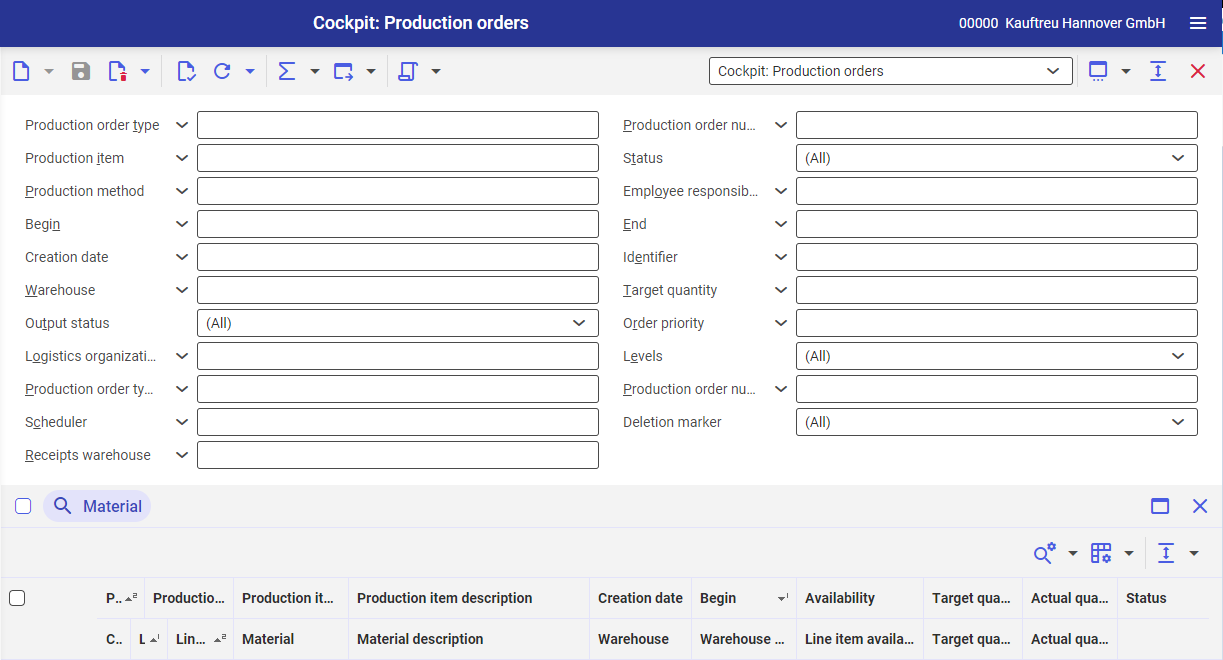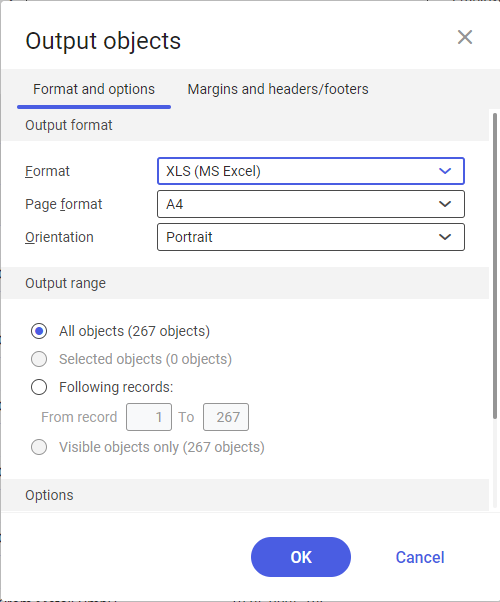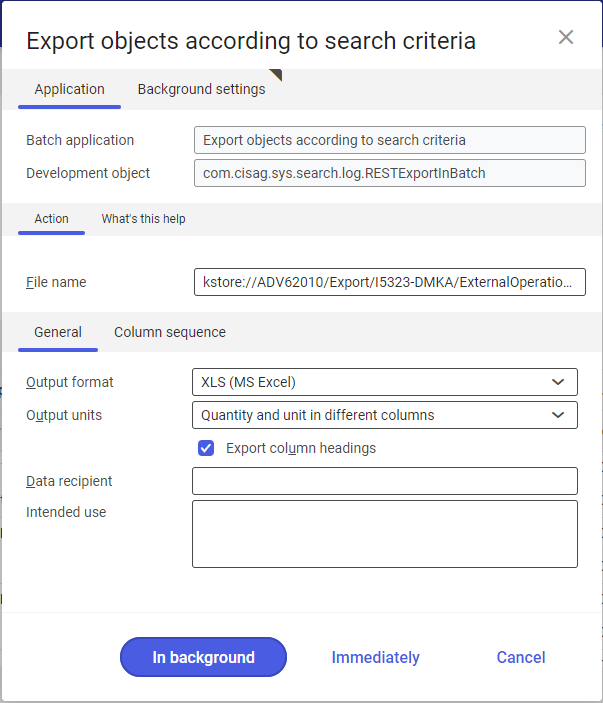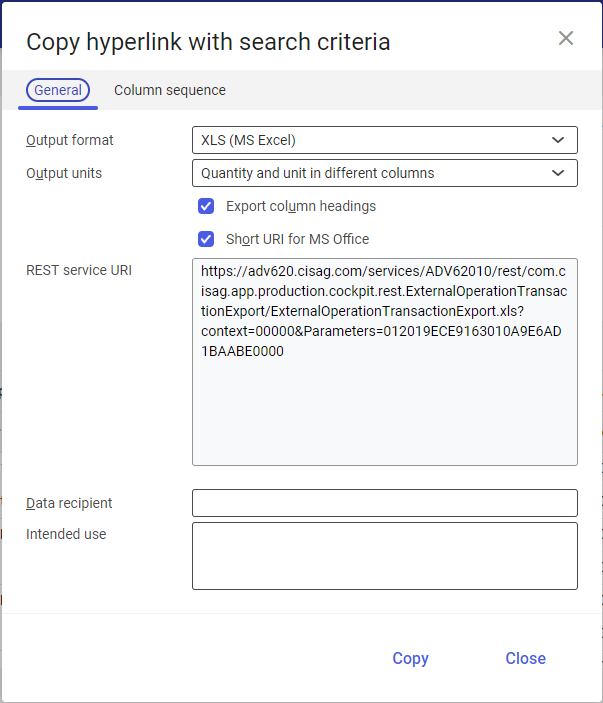In Cockpit: Production orders application you can view productions orders and the related resources and materials as well as process production orders. The application consists of:
- Query pane – contains the buttons and fields used to filter data displayed in the work pane table.
- Work pane – displays data according to the filter criteria specified in the query pane.

Query pane
The application query pane is handled with the following buttons:
[New] – opens an empty list sheet.
[Delete] – adds or removes a deletion marker for line item in the work pane table.
[Refresh] – refreshes data in the work pane.
[Refresh] → [Refresh (background)] – refreshes the work pane data in the background.
[Refresh] → [Stop] – stops the update process in case of a large amount of data to refresh.
[Refresh] → [Count objects] – recalculates the quantity of line items corresponding to the specified criteria. A relevant information message is then displayed.
[Calculate and display totals] → [All objects] – adds up of all the records displayed in work pane table. The total is presented in a separate row below the table. Totaled values are:
- Availability
- Target quantity
- Actual quantity
[Calculate and display totals] → [All objects with group totals] – adds up of all the record groups displayed in work pane table. The total is presented in an additional row below each group.
[Calculate and display totals] → [Selected objects] – adds up the records selected in the first table column. The total is presented in an additional row.
[Calculate and display totals] → [Hide totals] – hides all rows presenting totals of the records.
[Export] – exports data to a file. More information can be found in chapter Export of data.
- [Export] → [Export displayed objects]
- [Export] → [Export objects according to search criteria]
- [Export] → [Copy hyperlink with search criteria]
[Select action] – actions under this button can be executed for the line item selected in the work pane table. These actions are described in detail in the article Production orders .
Data in the application can be filtered by:
- Production order type – filters data in the table by production order type.
- Production order number – filters data in the table by production order number(s).
- Production item – displays data related with a specific production item.
- Status – filters data by status of the assigned production order.
- Production method – filters data by the defined alternative production method.
- Employee responsible – filters the production orders assigned to the selected employee.
- Begin – filters data by the specified production order processing start time.
- End – filters data by the specified production order processing end time.
- Creation date – filters production orders to those created on a specified date.
- Identifier – displays the production orders containing the materials with a specific identifier.
- Warehouse – displays the production orders containing the materials related with the selected warehouse.
- Target quantity – filters production orders to those containing the materials with a specified target quantity.
- Output status – displays the data with a specified output status of production order vouchers.
- Order priority – displays the productions orders with a defined priority.
- Logistics organization – displays data assigned to the selected logistics organization.
- Levels – filters production orders to those with a specific level of detail.
- Production order type of highest level – filters multi-level production orders whose main production order is of the selected production order type.
- Production order number of highest level – filters multi-level production orders whose main production order is of the selected production order number.
- Scheduler – displays the items assigned to a selected production scheduler specified in Items application under Planning
- Deletion marker – allows the selection of deletion marker-relevant items. Selectable options are:
- (All) – displays all items with and without a deletion marker.
- Marked as deleted – displays only the items marked for deletion.
- Not marked for deletion – displays only the items without a deletion marker.
- Receipts warehouse – filters production orders to those with a defined receipts warehouse of a produced item.
Export of data
[Export] → [Export displayed objects] action
This action exports objects currently displayed in the work pane table. It opens a dialog window Output objects.

The dialog window consists of the following tabs, sections and fields:
- Format and options tab – export settings are defined in this tab.
- Output format section – the basic settings, such as document format and orientation, can be defined in this section. Fields in this section are the following:
- Format – specifies the file format to which data will be exported. Available formats are XLS and PDF.
- Page format – specifies the sheet size. Available size values are: A4 and A3.
- Orientation – specifies the orientation of the exported document. Selectable options are Portrait and Landscape.
- Output range section – specifies a range of exported data. Fields in this section are the following:
- All objects – exports all records from the table.
- Selected objects – exports only selected objects from the table.
- Following records – exports only the table line items with numbers specified in From record/To
- Visible objects only – exports only the objects visible in the table.
- Options section – specifies additional export options:
- Output total lines – exports data together with the rows presenting totals.
- Display pictures – exports data together with defines images.
- Display colors – exports data as colored.
- Wrap to cell width – exports data from the table by wrapping text content to the defined column width.
- Utilize monitor font – exports data in the font used in the system.
- Scaling – scales the view of the exported data. Selecting the option Automatically adjusts the scaling value and selecting the option None sets the value to 100%. User-defined scaling allows the edition of the percentage value.
- Margins and headers/footers tab – specifies the margin size and the type of data to be displayed in the header and footer.
- Output format section – the basic settings, such as document format and orientation, can be defined in this section. Fields in this section are the following:
[Export] → [Export objects according to search criteria] action
This action exports the data as specified in the search criteria. It opens the Export objects according to search criteria window.

The dialog window consists of the following tabs, sections and fields:
- Application tab – detailed export settings are defined in this tab.
- Batch application – defines the application that will be run in the background to export the data.
- Development object – technical name of the application that exports data.
- Action section – contains the File name field in which you can specify the target folder path and the file name with exported data.
- General section – you can specify the format of the exported data in this section.
- Output format – file format into which data will be exported. Available file formats are: XLS, XLSX, CSV, XML, HTML.
- Output units – method of outputting units into an output voucher. Quantity and unit can be output in one column or in two separate columns.
- Export column headings (checkbox) – if selected, the data is output together with the table column headings.
- Data recipient – data recipient that will be added to the operation log file.
- Intended use – the purpose of data output, which will be added to the operation log file.
- Column sequence section – you can specify the column order in the output file in this section.
- Background settings tab – the batch job processing settings can be specified in this tab.
[Export] → [Copy hyperlink with search criteria] action
This action generates a link for downloading the defined file with data after typing it into the browser window. It opens the Copy hyperlink with search criteria dialog window.

The dialog window consists of the following tabs:
- General tab – you can specify the format of the exported data in this tab.
- Output format – file format into which data will be exported. Available file formats are: XLS, XLSX, CSV, XML, HTML.
- Output units – method of outputting units into an output voucher. Quantity and unit can be output in one column or in two separate columns.
- Export column headings (checkbox) – if selected, the data is output together with the table column headings.
- Short URI for MS Office (checkbox) – used to generate a short URI address.
- REST service URI – link address that needs to be copied in order to download the file with data.
- Data recipient – data recipient that will be added to the operation log file.
- Intended use – the purpose of data output, which will be added to the operation log file.
- Column sequence tab – you can specify the column order in the output file in this section.
Work pane
The application work pane displays data according to the filter criteria specified in the query pane. Buttons available in the table are the following:
- Hide/show ranges – used to modify the table view, selectable options:
- Hide/Show list header – hides/shows the table column heading.
- Hide/Show line status – hides/shows the column with the line status.
- Show/Hide grouping and sort area – by dragging the column heading into the highlighted area above the table header it groups data by the selected attribute as well as hides the area.
- Expand all groups – expands the grouped line items in the table.
- Reduce all groups – collapses all grouped line items in the table.
- Show all areas – shows all columns and their headings.
- Hide all areas – hides all columns and their headings.
Columns in the table correspond to the fields defined in the query pane.
